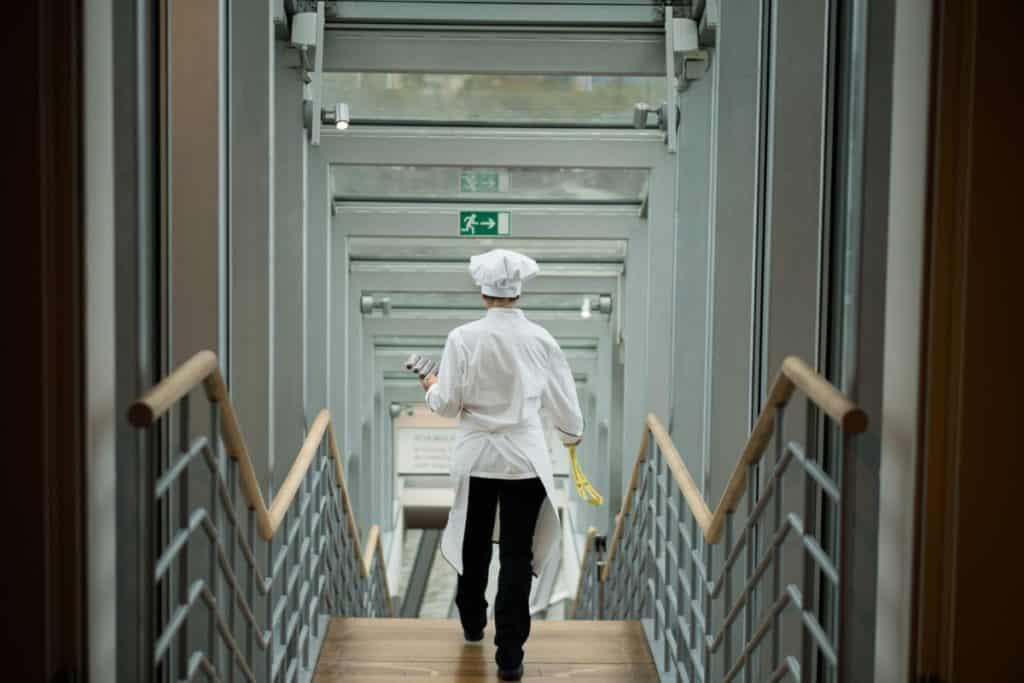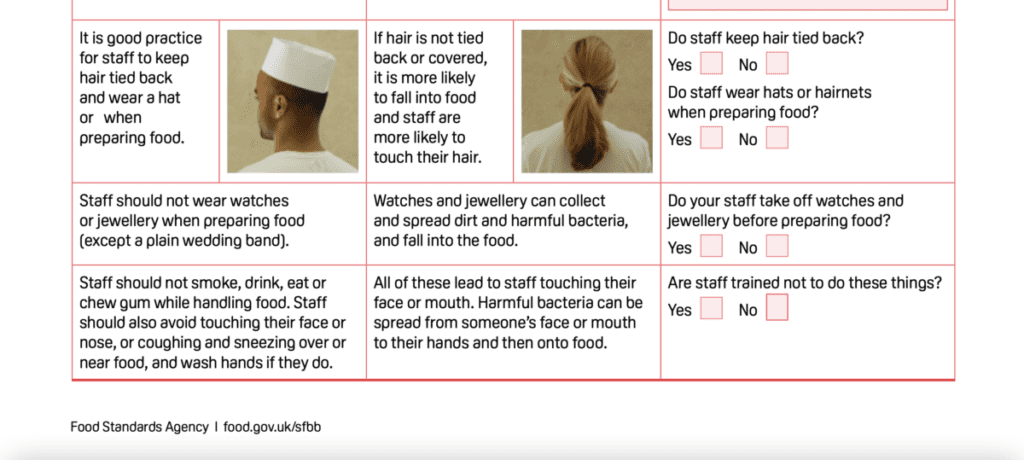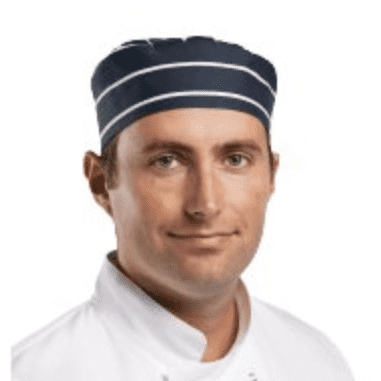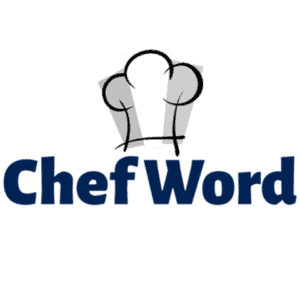One of the most instantly recognisable shapes in modern fashion culture is that of a traditional chef hat. The bordering-on-ridiculously tall hat is shaped like nothing seen elsewhere in fashion or workwear.
When we look at the traditional hat it certainly doesn’t look practical. If anything, having a tall flammable object placed on top of our head is a health and safety nightmare; so why do chefs wear tall hats?

The traditional tall white chef hat, (known as a toque blanche) was made famous in the early 1800s by legendary French chef Marie-Antoine Carême. The height traditionally symbolises rank, with the head chef having the highest hat in the kitchen. There are several theories for the folds.
Although not as popular as they once where, these type of hats can still be found in kitchens today as this video demonstrates.
Why Do Chef Hats Have Folds?
As with all origin stories, it can be tricky to determine exactly what was symbolised by the folds, or pleats in the hat; but there are two main schools of thought regarding them.
- The many folds in a chefs hat (possibly as many as 100) demonstrate the number of different ways to cook an egg.
- Other thoughts are that the number of folds is an indication of experience level and rank; i.e. the more folds, or pleats in a chefs hat, the more recipes they are able to cook, and the greater their experience level.
I have tried wearing one of these hats (admittedly a lightweight one made of a paper material ) during work and I can tell readers that they are far from comfortable, plus I just felt rather silly!
) during work and I can tell readers that they are far from comfortable, plus I just felt rather silly!
Why Are Chef Hats White?
White is the traditional colour of a chefs uniform as it is believed to offer the highest level of cleanliness. Popular belief is that white was chosen by legendary French chef Marie-Antoine Carême.
The natural choice was to choose white for the hat also, and that is why it became known as the toque blanche (translated to white hat).
White is seen as the most hygienic colour as it highlights any dirt and debris that is spilt onto the uniform. This was especially important centuries ago.
as it highlights any dirt and debris that is spilt onto the uniform. This was especially important centuries ago.
However, with modern day hygiene standards chefs are moving away from traditional white as our uniform is washed daily regardless of how it looks to the eye.
as our uniform is washed daily regardless of how it looks to the eye.
What Are Traditional Chef Hats Made From?
As referenced earlier, the times in my career when I have been required to wear a traditional toque blanche, it has always been the disposable paper type.
Traditionally, chef hats (or toques as they are called) are made from cotton as it is a lightweight and most importantly, very breathable.
I have only had to wear a traditional toque blanche a few times when doing a customer facing role, such as a bbq for guests out on the terrace. This gives the impression to the customer of a traditional chef in the traditional uniform and is something guests seem to enjoy seeing.

These lightweight paper hats are pretty uncomfortable as they tend to slid down onto the top of your ears. This means that the thin paper material is ‘digging’ into the top of your ears whilst wearing it. They also have a habit of slipping down over your eyes!
Over the course of several hours , the constant need to slide the hat back up becomes an irritation. Removing the hat at the end of a shift is always a pleasure; anyone who wears glasses will know that wearing even a lightweight object begins to get frustrating over time and will be familiar with the ‘ahh’ feeling when taking them off at the end of the day.
, the constant need to slide the hat back up becomes an irritation. Removing the hat at the end of a shift is always a pleasure; anyone who wears glasses will know that wearing even a lightweight object begins to get frustrating over time and will be familiar with the ‘ahh’ feeling when taking them off at the end of the day.
Thankfully by the time I started my chef career, the idea of everyone working in these traditional hats had passed.
Do Chefs Have To Wear Hats?
The food standards agency guidelines recommend that everyone that handles food should wear a hair covering of some description. However, this is a guideline and therefor individual chefs are free to not wear a hat if they choose and the kitchen they work in allows it.
Many chefs argue that in the hot environment of a kitchen, wearing a hat makes our head unnecessarily hot and sweaty. This encourages chefs to take their hats on and off to get some respite from the heat and allow their head to breath.
Constantly removing the hat and placing it back on actually encourages more hair touching, and therefor a greater chance of hair falling out, than if we didn’t wear a hat at all.
I have personally worked in both, kitchens that insist hats be worn and those that do not enforce it. My personal opinion is that the heat retention in my head when wearing a hat makes an already uncomfortably hot environment  very difficult to be in; especially on warm days.
very difficult to be in; especially on warm days.
By not wearing a hat we touch our head less and therefor there is much less chance of hair contaminating food.
How many times have we found hair in our dinner cooked at home whilst not wearing a hat? Hair contamination in food is not common place regardless of hat wearing or not.
That being said it is a guideline of best practice and I can understand why some kitchens choose to enforce this rule. Thankfully there are many options available today in addition to the traditional chef hat!
and I can understand why some kitchens choose to enforce this rule. Thankfully there are many options available today in addition to the traditional chef hat!

What Hats Do Modern Chefs Wear?
Fortunately for chefs there are many options to choose from when it comes to headwear. Alongside the traditional chef toque there are beanies, skull caps, wraps, baseball hats and caps to name just a few.
Different hats are more suited to different environments. I will briefly discuss each type below as well as when they will be most suitable.
During my career I have worn (perhaps the most common hats to see within professional kitchens) the skull cap and the baseball cap options. Although there have been customer facing roles mixed in, where I have been required to don the traditional tall white hat!
I have worn (perhaps the most common hats to see within professional kitchens) the skull cap and the baseball cap options. Although there have been customer facing roles mixed in, where I have been required to don the traditional tall white hat!
Usually if a kitchen requires that their chefs wear hats they will provide them so a new chef does not need to worry about rushing out to buy one before their first shift!
The types of modern hats available to chefs are:
Traditional Toque
Although possibly considered rather silly looking and outdated some kitchens still want to maintain the tradition.
As mentioned earlier, when I have been asked to cook a bbq on the terrace for the hotel guests , this has been the hat I have been required to wear as customers seem to really enjoy it and it is a talking piece whilst you are preparing their food.
, this has been the hat I have been required to wear as customers seem to really enjoy it and it is a talking piece whilst you are preparing their food.
Beanies and Skull Caps

These fall under the same category as they are very similar and are one of the most common type of hats you will come across in a modern kitchen.
They are lightweight and relatively unobtrusive as they sit high on the head. The availability of many different colours and patterns make them a great choice for chefs who want to shoe off their creative fashion sense!
Catering hats
Hats that incorporate a net, or even the soft shaped hair nets alone, are often referred to as catering hats.
We will typically find these in food production environments such as factories where the absolute highest standards of hygiene are required. I have never seen these hats being worn in a standard kitchen setting except the odd school canteen kitchen.
environments such as factories where the absolute highest standards of hygiene are required. I have never seen these hats being worn in a standard kitchen setting except the odd school canteen kitchen.
Head-wraps
A popular choice for some are head wraps. The fact that they can be wrapped around any type of hair style makes them an ideal option for certain hair styles where the popular skull cap would struggle to fit over.
Baseball caps
These are as popular as skull caps in certain catering environments. Many chefs already own and enjoy wearing baseball caps so to wear one of these at work doesn’t feel like an inconvenience.
In my experience, more traditional, and dare I say higher quality level kitchens (I’m picturing Michelin star level) do not like their chefs wearing baseball caps. They are viewed by some chefs as being a little too casual and sloppy.
level) do not like their chefs wearing baseball caps. They are viewed by some chefs as being a little too casual and sloppy.
If the chefs are wearing the traditional chef whites uniform, it is highly unlikely they will be allowed to wear a baseball cap alongside it.
Disposable hats
Disposable hats are made from paper and come in all different shapes and sizes. The benefit of this option is that they are cheap and no need to wash them. Perfect for occasions when a unique hat is required for a special function or event.
The downside is the environmental damaging factor associated with anything that is disposable.
Alongside the environmental factor is the fact that in my experience, they are simply not very comfortable. Although a paper disposable hat is incredibly lightweight, they have a habit of constantly slipping down over my eyes!!
All these hats can be viewed and bought at the extremely popular catering website nisbets.com. Readers can find all these styles in a huge variety of colours and other options on their website linked here.
To Sum Up
Whilst the traditional chef hat was a staple in the kitchen for centuries it has largely been phased out in favour of more modern and practical options.
Where as traditionally the height of the hat symbolised a chef’s rank within the kitchen, this type of ‘peacocking’ is seen as outdated and unnecessary in modern kitchens.
However, make no mistake, when entering a kitchen it is easy to spot the head chef by the way they carry themselves and the way other members of the brigade interact with them.
Although the traditional hats may be disappearing, the traditional rank structure and respect given to each other remains as strong as ever.
